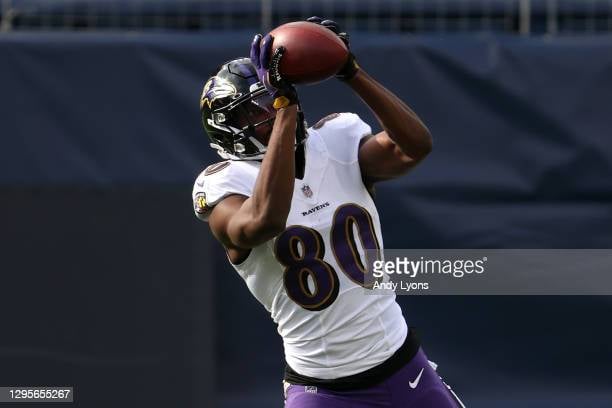As reported Tuesday afternoon, WR Miles Boykin was claimed off of waivers by the Pittsburgh Steelers after being released by the team that drafted him, the Baltimore Ravens. It’s a typical ‘Steelers move,’ claiming Boykin as there was plenty of pre-draft interest from the organization when he was coming out of Notre Dame in 2019. At nearly 6’4″, 220 pounds, Boykin lit up the NFL combine with a 4.42 40 with a 43.5-inch vertical, 11’8″ broad jump, and impressive shuttle times. Now, at only 25 years old, the Steelers are able to take flier on the freak athlete. With that, here is a breakdown of what Boykin has put on tape during his relatively underwhelming first three years in the NFL.
GOOD
— Good burst off the line of scrimmage
— Shows ability to vertically stack
— Understands how to manipulate leverage of corners, especially on posts
— Smooth and has good acceleration through cuts
— Long, lengthy frame enables a large catch radius
— Can use strength to power through physical corners
— Will use size, strength to consistently fall forward after the catch
— Has the ‘want to’ in the blocking game
— 417 total special teams snaps in career
BAD
— Limited route tree shown on film
— Can be awkward catching the football
— Not many contested catches shown in NFL
— Not dynamic after the catch
— Quits on routes when doesn’t think he’s open
— More drops than you’d want to see in limited targets
— Was clear he was not on same page with QB at times
FILM BREAKDOWN
In 2021, Miles Boykin was limited to just eight games because of a hamstring injury. While being hamstrung by injury (pun very much intended), Boykin found himself buried in the depth chart. Aside from his one catch for six yards in 2021, it left Boykin to be mostly a special teams depth piece for the Ravens in his third year. After failing to trade him, Baltimore chose to cut bait. Due to his lack of usage in 2021, we’ll be focusing mostly on Boykins 2020 tape, let’s dive in.
With the Steelers’ offense yearning for a deep threat in this offense, the first thing we’ll talk about is Boykin’s ability to stretch the field. Below against Cincinnati, Boykin is sent on a post route off of play-action. He’s able to use his long strides to eat up the corner’s cushion quickly. Just as the corner opens the gate outside, Boykin explodes inside, seemingly losing no speed. This causes a “baseball turn” from the DB, leaving Boykin wide open to catch the deep touchdown pass.
While he didn’t show it on the previous rep, I always look for the receiver’s understanding of cornerbacks’ leverage and how to manipulate it. Here, Boykin is able to press at the outside shoulder of the cornerback, making him expand. As soon as he gets the corner to expand he uses a “bam step” to explode inside to the space he just created for himself. While he doesn’t get the ball here, have to note his willingness to chase the quarterback in the scramble drill as well.
Boykin also shows the ability to vertically stack defenders. He has a great first step and burst off the line. Both times, he is able to use his quickness and acceleration to sidestep the defenders before getting vertical. Unfortunately, he wasn’t awarded with a catchable ball on either rep.
Boykin is gifted with 33 1/2″ arms and they come in handy on plays like this where has to show off his catching radius.
Boykin shows great fluidity on tape. Most of the routes in Baltimore they had him running were speed outs, drags, and deep overs, all routes that allow you to carry your speed without definitive cuts. With these, he’s able to get open a ton, but as seen below, not always targeted. This one would have been an easy touchdown if Lamar Jackson didn’t have another wide-open receiver on the other side of the field.
I’ll apologize as most of Boykin’s impressive tape was actually on plays he never received the football. Most of his catches were on simple stop routes in zone or overs, as I mentioned above, that doesn’t show much other than a routine catch. He’s definitely raw as a route runner as his route tree was extremely simple in Baltimore. He wasn’t really able to show much more than he did at Notre Dame. If he did break open, there weren’t many anticipatory throws to him on the outside. We can dive into why that may be, now.
On this comeback, Boykin gets caught looking at the cornerback breaking on the ball. He is also seemingly late with his break and getting his head turned around. You can see how he takes an extra step upfield after breaking down and THEN he gets his head around. That extra step should have been outside with his head snapping back at the quarterback. That extra is all it takes to turn a third-down conversion into an interception.
Here’s another example where Boykin and Jackson weren’t on the same page. On 3rd and 12, Boykin is on a boundary go-route. The cornerback is in a pedal and has good positioning off the snap. At the 43-yard line, Boykin begins to expand his route and power down. That body language and the leverage of the corner, cause Jackson to throw back-shoulder. Except, Boykin never looks back until he’s at the opposite 40-yard line.
This type of play is something that needs to be repped over and over in practice with your quarterback, but with the full context of the play, it should be an easy decision for Boykin to expect and WANT a back-shoulder here. It’s the type of play we saw Chase Claypool and Ben Roethlisberger not be on the same page on numerous times during Claypool’s frustrating 2021 campaign.
The Ravens evidently love their third-down 50/50 balls as much as the Steelers. Here’s another attempt where Boykin simply quits on the play altogether as he assesses himself as covered. Due to this, it looks like Jackson just throws it away.
From the tape I watched, Boykin has the strength, speed, and ability to fight through this contact and break down the sidelines. For whatever reason, he didn’t want to give the effort here. If he does, that ball may be catchable from Jackson.
I went through all 33 of Boykins targets in 2020 and these were all of the drops that I was able to find. None of these I’d classify as “easy” or “routine” drops, but they are plays that should be made by an NFL-caliber wide receiver, especially one that lacked opportunities.
Drop-rate is calculated by drops per catchable target. While I didn’t calculate the “catchable targets,” if you go simply off of his 33 targets, which would significantly help Boykin’s drop rate, it would be 9.1%. For reference, Diontae Johnson’s drop rate in 2020, when he led the NFL in drops, was 9.0%.
Back to the good with Boykin. One thing I harp on, if you read my weekly wide receiver film rooms from 2021, is the Steelers wide receivers’ lack of downfield blocking. This is an area that I believe Boykin can truly excel at and help this receiver room with. He has always been a willing blocker back to his days at Notre Dame and that didn’t change once he got into the run-heavy Baltimore offense.
Watch below, Boykin at the top of the screen. He’s running a curl and doesn’t get the football. The ball goes to the deep over route upfield about five yards from where he’s standing. Boykin could take the easy route and say, “I don’t want to get in my guy’s way, I’m five yards behind him.” Doing what I call “being a spectator.” Instead, he runs ahead of the ball carrier, pancakes the cornerback, and allows his man to pick up likely 10-15 more yards in doing so.
I don’t mean to continually pick on Chase Claypool, but I specifically outlined him a few times last year for being a spectator on plays just like this. Not only does it leave yardage on the field, but it also added more hits on to guys like Najee Harris in the process.
The last thing I wanted to touch on is Miles Boykin’s special team’s ability. If you weren’t aware, Raven’s head coach, John Harbaugh, was a special teams coordinator before being hired in Baltimore. Along with that, he often deploys some of the best special teams units year in and out, showing me he isn’t just putting anyone out there. In his three NFL seasons, Boykin has accumulated 417 special teams snaps. Those are the types of numbers a guy needs to be able to stick as a fifth or sixth receiver on an NFL roster.
I’ve pulled Boykin’s two special teams tackles from 2020 for you to take a look at. While they’re not anything spectacular, they got him on the stat sheet.
Baltimore also used Boykin on a fake punt. Lined up at the bottom of the screen as a gunner, Boykin has a nice get-off and throw by at the top of the curl. He’s able to reel it in for the fourth-down conversion.
CONCLUSION
Overall, Miles Boykin is exactly what the title states, a project. He has the tools to become an effective role player in the NFL. At this point, it’s hard to expect him to be much more than an average NFL starter if needed, but that’s a role Pittsburgh needs right now. If Boykin is able to make the roster, I could see him as a depth piece at the Z-position that can be used in case of a Claypool injury as well as giving them some flexibility with moving Claypool around.
His special teams and blocking ability gives him a big leg up to make this roster. While looking at the athletic makeup and playing style may remind you a good bit of Claypool, his blocking ability and special teams experience has him cut from the same cloth as Cody White. Those are the two, at this point, I think end up fighting for the last roster spot at wide receiver. The tie there, however, normally goes to the player with the higher overall ceiling (Boykin in this case).
This signing is nothing more than simply taking a chance on a player with some rare traits that you may be able to mold around. It doesn’t change the draft planning at all and in the worst-case scenario, you can cut him before week one. No harm, no foul.
What are your thoughts on the Steelers bringing in Miles Boykin? Do you see him making an impact in the Steelers wide receiver room? Please leave your thoughts in the comments section below and thanks again for reading!







